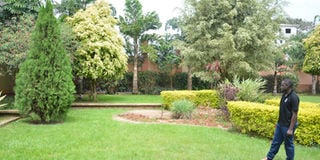Design compounds for cash

A man walks in a compound. Landscaping can be done for universities, homes, schools recreation centres, hospitals, camping sites, estates and hotels, among others. PHOTO BY GODFERY LUGAAJU
What you need to know:
Landscaping is one of those jobs where you can pocket cash you need on the day you need it. Dorothy Nakaweesi writes about what it takes to start this business giving you an idea on the proceeds.
Compound designing or call it landscaping is on demand and is highly marketable. It involves any activity that modifies the visible features of an area of land, including: living elements, such as flora or fauna; or what is commonly called gardening, the art and craft of growing plants with a goal of creating a beautiful environment within the landscape.
It is an upcoming lucrative business in this era because many developers are now interested in having well-designed compounds that are be-fitting to their modern homesteads.
This can be done for Universities, homes, schools recreation centres, hospitals, camping sites, estates and hotels among others.
Investment
The most important investment capital one can inject in this kind of business for starters is passion for landscaping/compound designing according to Mr Moses Karikwisya, the managing director Karmos Limited.
Karmos Limited has specialists in compound designing and nursery gardening. This involves plant propagation of seedlings and plants care, landscape planning and designing.
He says: “I started out small with a few tools like a pair of scissors, plastic bags and a few plants.”
For the last 15 years, he has grown the business that has supported his family to three outlets.
If you want to start this business on a large scale according to Uganda Investment Authority estimates, you should have investment capital worth $21,864 (Shs80 million) to handle the demand.
The project is estimated to yield a net profit margin of 56 per cent premised on at least 312 compounds designed in a year and this will payback in a period of about one year and nine months.
This means annually, one will be assured of about $49,920 (Shs182 million) in revenue collection from the designs done.
Production costs assumed are for 312 days per year with daily capacity of one compound.
Direct costs include materials, supplies and all other costs that directly go into production of a product.
Processes
The first step to starting a landscaping business is to acquire your arsenal of landscaping equipment.
The process starts as the premises near completion or when civil works are in the final stages.
Levelling of the compound commences, black soil is mixed with composite and planting of grass, flower, trees, hedges etc. follows. Pavements, pavers and any arches are
all put in place.
Constant irrigation or watering is done to speed up growth. The placing of lights are identified and if procured, they are fixed.
Marketing
Compound designing, a new development driven by modernisation, has market potential among the affluent, institutions and recreation centres among others.
Materials
When starting out, you can rent your equipment or to buy lower-grade equipment. But as the business grows, so will equipment costs—and you could easily spend the same amount on maintaining cheap equipment as the price of purchasing higher-grade machines.
There are a handful of manual tools any good landscaper has at their disposal: shovels (such as square-mouth, spade, and trench), wheelbarrows, tillers (such as rear-tine tillers or cultivators), and more powerful items like chainsaws and drills. But this isn’t where the real expenses lie.
The beauty is that the equipment and materials can be sourced locally.
Advice
Mr Karikwisya: “This is a profitable business for people who are patient since the demand for services is seasonal.”
He adds that before putting money in this business, research on customer preferences, where to source the materials to use and if need be acquire some skills in compound designing.
His advice for anyone who wants to invest in this kind of business is to start small and eventually expand.




